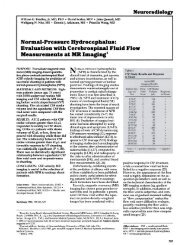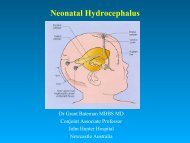Definition and Classification of Hydrocephalus
Definition and Classification of Hydrocephalus
Definition and Classification of Hydrocephalus
Create successful ePaper yourself
Turn your PDF publications into a flip-book with our unique Google optimized e-Paper software.
<strong>Definition</strong> <strong>and</strong> <strong>Classification</strong> <strong>of</strong> <br />
<strong>Hydrocephalus</strong> <br />
Harold L Rekate MD <br />
Pr<strong>of</strong>essor <strong>of</strong> <br />
Neurosurgery <br />
H<strong>of</strong>stra Northshore LIJ <br />
School <strong>of</strong> Medicine
<strong>Classification</strong> Consensus <br />
Study Group <br />
• Harold L. Rekate M. D. Michael Pollay M.D. <br />
• Petra Klinge M.D. Conrad Johansson PhD <br />
• J. Patrick McAllister PhD.<br />
Gordon McComb M.D. <br />
• John Pickard M.D. Jack Walker M.D. <br />
• Shizuo Oi M.D. Charles Teo M.D. <br />
• Osamu Sato M.D. Concezio Di Rocco M.D. <br />
• Martina Messing-‐Junger M.D. Spyros Sgouros M.D. <br />
•
Cerebrospinal Fluid Research<br />
Review Open Access<br />
The definition <strong>and</strong> classification <strong>of</strong><br />
hydrocephalus: a personal<br />
recommendation to stimulate debate<br />
Harold L Rekate<br />
Published: 22 January 2008<br />
Cerebrospinal Fluid Research 2008, 5:2 doi:<br />
10.1186/1743-8454-5-2<br />
Received: 15 October 2007<br />
Accepted: 22 January 2008<br />
This article is available from: http://<br />
www.cerebrospinalfluidresearch.com/content/5/1/2
How it Began
After Consensus Meetings
Using the <strong>Classification</strong> Scheme <br />
• <strong>Classification</strong> based on point <strong>of</strong> obstruction <br />
– Modified by differential diagnosis <br />
• Modified by potential treatment options <br />
– Modified by time <br />
» Acute <br />
» Chronic <br />
» Compensated <br />
» Arrested
Foramen <strong>of</strong> Monro <br />
Pathologic Process <br />
Possible treatments <br />
• Shunt <br />
• Congenital Atresia <br />
• Tumors <br />
• Functional obstruction <br />
• Septum <br />
Pellucidotomy <br />
• Opening <strong>of</strong> the <br />
foramen <strong>of</strong> Monro
Foramen <strong>of</strong> Monro <br />
Animal Model <br />
• D<strong>and</strong>y et. al. 1919 <br />
• Occluded the foramen <strong>of</strong> Monro in kaolin hydrocephalus <br />
• D<strong>and</strong>y, W. E. "EXPERIMENTAL HYDROCEPHALUS." Ann.Surg. 70.2 (1919): 129-‐42. <br />
Rekate <br />
• Functional occlusion <strong>of</strong> Foramen <strong>of</strong> Monro with ipsilateral ventricular drainage <br />
• Rekate, H. L., et al. "Resistance <strong>of</strong> the foramen <strong>of</strong> Monro." Pediatr.Neurosci. 14.2 (1988): <br />
85-‐89.
Aqueductal Stenosis <br />
• Congenital Acquired <br />
• X-‐linked <br />
• Tumor <br />
• Ventricular Shunting <br />
• ETV <br />
• Aqueductoplasty <br />
• Chronic Shunting <br />
• LIAS (Chronic <br />
Compensated)
Aqueductal Stenosis <br />
Animal Models <br />
• AS produced by injection <br />
• Secondary closure <strong>of</strong> aqueduct from primary hydrocephalus in HTx Rat <br />
• Aikawa, H. <strong>and</strong> K. Suzuki. "Aqueduct stenosis induced by a single injection <strong>of</strong> <br />
antivitamin." Brain Res. 354.2 (1985): 284-‐87 <br />
Data following ETV in LOVA patients <br />
Rekate, H. L. "Longst<strong>and</strong>ing overt ventriculomegaly in adults: pitfalls in treatment <br />
with endoscopic third ventriculostomy." Neurosurg.Focus. 22.4 (2007): E6.
Fourth Ventricular Outflow <br />
• Late after acute meningitis <br />
• Chronic meningitis <br />
• Arachnoiditis <br />
• Congenital anomalies <br />
especially D<strong>and</strong>y-‐Walker <br />
Malformation <br />
• Brain Tumor <br />
• ETV <br />
• Aqueductoplasty from <br />
above or below <br />
• Lysis <strong>of</strong> obstructive <br />
membranes <br />
– Endoscopic <br />
– Open <br />
• Removal <strong>of</strong> Tumor
Animal Models <br />
Intracisternal injection <strong>of</strong> kaolin in dogs produces hydrocephalus by <br />
occluding the outlet foramina <strong>of</strong> the fourth ventricle with intense scarring <br />
Also a model <strong>of</strong> syringomyelia <br />
McCormick, J. M., et al. "Time course <strong>of</strong> intraventricular pressure change in a <br />
canine model <strong>of</strong> hydrocephalus: its relationship to sagittal sinus <br />
elastance." Pediatr.Neurosurg. 18.3 (1992): 127-‐33. <br />
In most reports <strong>of</strong> the use <strong>of</strong> kaolin in animal models the pathophysiology <strong>of</strong> <br />
the hydrocephalus is either not defined or is stated to be <br />
“communicating.”
What Is Accomplished by <br />
Performing an ETV
Cortical Subarachnoid Space <br />
Clinical Relevance <br />
• Subarachnoid hemorrhage <br />
• Meningitis <br />
– Please note, blockage <strong>of</strong> the CSAS <br />
can be either at skull base or at point <br />
<strong>of</strong> terminal CSF absorption!!!! <br />
Siomin, V., et al. "Endoscopic third <br />
ventriculostomy in patients with <br />
cerebrospinal fluid infection <strong>and</strong>/or <br />
hemorrhage." J.Neurosurg. 97.3 <br />
(2002): 519-‐24 <br />
Treatments available <br />
• Shunt <br />
• Lumbo-‐peritoneal shunt <br />
• If previously normal ventricle <br />
size has been demonstrated <br />
<strong>and</strong> the ventricles exp<strong>and</strong> the <br />
patient is a c<strong>and</strong>idate for ETV <br />
• .
Animal Model <br />
• “Extraventricular obstructive hydrocephalus” McAllister <br />
• Transbasal injection <strong>of</strong> kaolin to seal the cortical subarachnoid space. <br />
Mild to moderate hydrocephalus results late in the course <strong>and</strong> <br />
communication with the spinal subarachnoid space is documented <br />
• Li, J., et al. "Communicating hydrocephalus in adult rats with kaolin <br />
obstruction <strong>of</strong> the basal cisterns or the cortical subarachnoid space." <br />
Exp.Neurol. 211.2 (2008): 351-‐61. <br />
• Wagshul, M. E., et al. "Ventricular dilation <strong>and</strong> elevated aqueductal <br />
pulsations in a new experimental model <strong>of</strong> communicating <br />
hydrocephalus." Exp.Neurol. 218.1 (2009): 33-‐40.
Venous Obstruction <br />
Clinical Relevance <br />
• Only causes hydrocephalus in <br />
infancy <br />
• Benign intracranial hypertension <br />
in adults <br />
• Aqueduct shown to secondarily <br />
close <br />
• Severe slit ventricle syndrome or <br />
Normal Volume <strong>Hydrocephalus</strong> <br />
• 20-‐25% <strong>of</strong> early shunts <br />
Treatment available <br />
• Ventricular shunts with very <br />
high resistance valves <br />
• Lumboperitoneal shunts <br />
• Cisterna magna shunts <br />
• Venous bypass or venous <br />
stenting
Animal Model <br />
• Sagittal Sinus occlusion in Rabbits <br />
– Pseudotumor when skull in tact <br />
– <strong>Hydrocephalus</strong> if accompanied by craniectomy." Olivero, <br />
W. C. <strong>and</strong> N. Asner. "Occlusion <strong>of</strong> the sagittal sinus in <br />
craniectomized rabbits." Childs Nerv.Syst.
No Point <strong>of</strong> Obstruction <br />
• Essentially this has only <br />
been shown to occur <br />
clinically in the context <strong>of</strong> <br />
choroid plexus papilloma <br />
• Rekate, H. L., et al. "Etiology <strong>of</strong> <br />
ventriculomegaly in choroid plexus <br />
papilloma." Pediatr.Neurosci. <br />
12.4-‐5 (1985): 196-‐201. <br />
• Animal Models <br />
– Amplification <strong>of</strong> pulsations <br />
– Di, Rocco C., et al. "Experimental <br />
hydrocephalus following <br />
mechanical increment <strong>of</strong> <br />
intraventricular pulse pressure." <br />
Experientia. 33.11 (1977): 1470-‐72. <br />
Bulk flow infusion <strong>of</strong> artificial <br />
CSF over long periods









